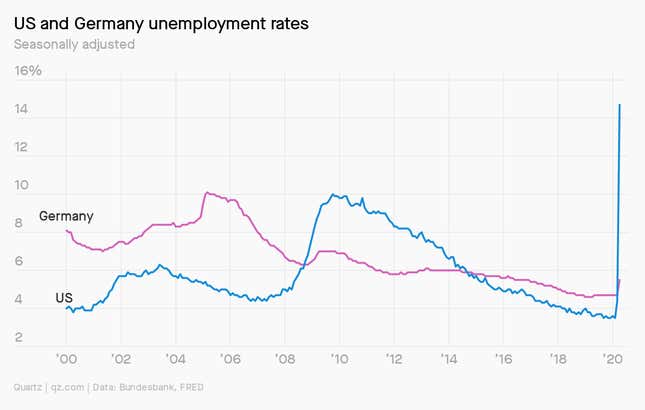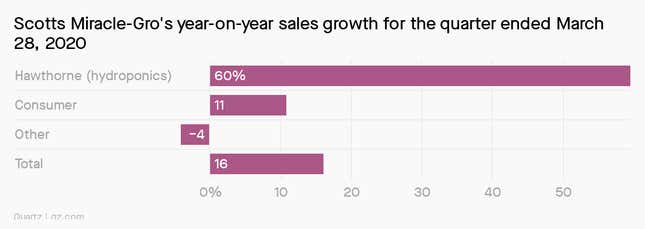Hello Quartz readers,
Over the past week, a country held hostage by Covid-19 has turned its attention to a much older public health crisis: police brutality, and the conditions that allow it to thrive. As the American Medical Association put it on May 29, excessive police force “is a communal violence that significantly drives unnecessary and costly injury, and premature morbidity and death.”
Both crises disproportionately impact the same community. African Americans are nearly three times more likely to be hospitalized than non-Hispanic whites for severe complications from coronavirus, because they tend to suffer more from chronic preexisting conditions like diabetes, obesity, and cardiovascular disease. These health conditions are directly linked to socioeconomic ones.
There’s no vaccine for police brutality, but there are treatments. Community-based policing could reduce violently racist actions by officers. Even in this moment, it’s not a crisis that can wait.
Rating to exhale
The US and German unemployment rates appear to be on different planets: The US’s official rate spiked from 3.5% in February to 14.7% in April, while Germany’s rose from 4.7% to 5.5% in the same period. Below the surface, however, the countries are experiencing similar pain.
The divergence stems from differing approaches to supporting companies and workers. As lockdowns ripped through the global economy, nations like the US and Canada have mainly relied on beefed-up unemployment benefits to cushion the fall. Under Germany’s Kurzarbeit, which translates to “short-time work,” financially distressed employers can drastically reduce worker hours, and the government will pay most of their lost wages.

Government subsidies for short-time working programs, also used in countries like Japan, Australia, and the UK, are designed to preserve the relationship between workers and employers, hopefully speeding up an eventual recovery. This policy can be especially useful for firms at risk of losing highly skilled workers they’ve invested in.
By contrast, the US and Canadian approaches rely more heavily on unemployment benefits. This could turn out to be a better policy if the pandemic causes longer-lasting changes—if workers have lost jobs that aren’t coming back, a German-style short-time working program may only delay the inevitable.
Regardless of the type of safety net, hourly work data shows the pandemic has roiled the global labor market. The number of hours worked in the US fell 17% in the US in April from two months earlier, according to a research note by Goldman Sachs economists Jan Hatzius and Daan Struyven. That compares with a 23% plunge in Germany and a 28% drop in Canada.

Goldman expects that government support in developed economies will keep household disposable income at about the same level it was before the crisis, despite the deepening malaise. But Hatzius and Struyven think North American employment will take longer to bounce back than in some European countries. They forecast the unemployment rate in the US will be around 12% at the end of the year, compared with less than 4% for Germany.
You asked
Will the rush to create a new Covid-19 vaccine compete with the deployment of regularly scheduled flu vaccines for the fall?
Luckily, flu vaccine manufacturers are on their toes year-round.
There are five research centers that collect data on circulating flu viruses. About six months before the next flu season should start, the World Health Organization evaluates data from all these centers, and flu vaccine manufacturers update their products to protect against the strains the WHO predicts will be going around. It’s a pretty well-oiled system, and any Covid-19 vaccine in the pipeline shouldn’t disrupt it. While some flu vaccines are made by larger drug companies, which could eventually make Covid-19 vaccines, many are made by smaller companies that only produce flu vaccines—so no competition.
However, there are two ways that Covid-19 could disrupt this flow: First, the pandemic may increase people’s desire to get vaccinated against the flu, meaning that there could be shortages. Second, if the pandemic has prevented flu vaccine manufacturers from coming into work, it could cause a delay in production.
✉️ What’s your burning coronavirus question?
Sourdough to Sour Diesel
For the past few years, Scotts Miracle-Gro, the maker of home, lawn, and garden-care goods, has attributed a growing portion of its sales to Hawthorne Gardening, a subsidiary that owns brands selling supplies for hydroponic cannabis cultivation. In 2019, Hawthorne accounted for over 20% of Scotts Miracle-Gro’s revenues, up from 5% in 2016.
Then came the quarantine gardening boom. Hawthorne’s $230 million in earnings for the quarter ended March 28 were up 60% year-over-year, compared with 11% for Miracle-Gro’s consumer division sales. The cannabis-focused business is a smaller piece of the pie, but growing much faster.

“We’re shipping more out the door than we ever have before,” said Hawthorne head Chris Hagedorn on an earnings call May 6. “We joked when all this started—not that it’s a joking matter, but you’ve got to find levity where you can … What were people going to do when quarantine hit the whole country? They’re going to sit at home and smoke pot and garden. And I think, in all seriousness, there’s a lot of truth in that statement.”
Two’s a crowd
As The Great Reopening begins around the world, we’re catching a glimpse of how the hospitality industry contends with social distancing. Honestly, we don’t always hate it:
- In Maryland, an Ocean City bar is using individual bumper-boat-style tables (on wheels) to keep customers six feet away from each other.
- In Germany, Burger King debuted giant social distancing crowns to make sure diners keep their distance. In Italy, Burger King is selling a Social Distancing Whopper with extra onions for repellant breath.
- In Florida, theme park and wildlife preserve Gatorland introduced a new mascot: the Social Distancing Skunk Ape. (Because truly, who’s better at social distancing than Bigfoot?)
Essential reading
- The latest 🌏 figures: 6,325,303 confirmed cases; 2,727,679 classified as “recovered.
- Flywheel justice: Amazon turns in its own sellers for Covid-related price gouging.
- While you were gardening: The Franco-German bailout could secure Europe’s future.
- Dinner on the rocks: Americans are buying more frozen food.
- Settlers of caftan: Coronavirus is making way for a tabletop game renaissance.
Our best wishes for a healthy day. Get in touch with us at needtoknow@qz.com, and live your best Quartz life by downloading our app and becoming a member. Today’s newsletter was brought to you by Annalisa Merelli, John Detrixhe, Jenni Avins, Katherine Foley, and Kira Bindrim.